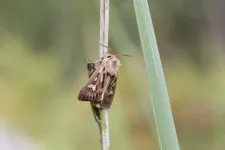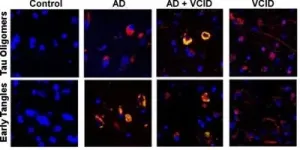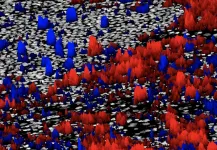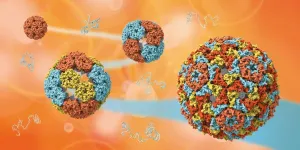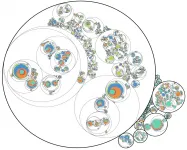(Press-News.org) Just as the governor announced the start of python hunting season in Florida this month, researchers at the University of Central Florida have published a first- of-its-kind study that shows that near-infrared (NIR) spectrum cameras can help hunters more effectively track down these invasive snakes, especially at night.
The snakes, which can reach 26 feet in length and 200 pounds, have invaded the Everglades in Florida -- threatening native species and disrupting the ecosystem. The number of common native species observed in the Everglades since the snakes were first discovered in the 1990s dropped in some species by 90% through 2010, according to an earlier study. Since then, the state has been implementing mitigation strategies and encouraging residents to hunt down the massive snakes. On average snakes removed from the Everglades are about eight feet long, according to the Florida Fish and Wildlife Conservation Commission.
The new study found that by using NIR cameras, pythons could be detected 20 percent farther away than with visible cameras. Researchers say that with more work they may be able to develop an automated snake detection system. That could be a game changer especially since the pythons are marching northward and could threaten native species as far north as Virginia and Texas to the west.
"Manual removal of Burmese pythons has been the most effective management strategy, but snakes are difficult to see due to their natural camouflage," says Kyle Renshaw, a co-author of the study and an assistant professor at CREOL - UCF's College of Optics and Photonics. "NIR cameras will help python hunters find and remove pythons. These small, inexpensive cameras could be mounted on trucks or drones to help catch the hard-to-find pythons. Using cameras also opens the possibility for automated detection using computer algorithms to search the imagery faster and more comprehensively than the hunters can do on their own."
Jennifer Hewitt, a graduate student in Renshaw's lab led the study, which was published this week in the journal Applied Optics.
This research is one example showing how cameras can be "tuned" to improve performance of a specific task, the researcher say. The detection band, time constants, lens parameters, image processing and algorithms provide a rich set of variables to optimize a camera system for a particular application. The work with the snakes was based on viewing from a stationary position, but the team hopes to expand its work to include moving sensors.
"That could have big applications in search & rescue, explosives detection, border security, etc.," Renshaw says. "Jen is developing and testing models for time-limited search using a moving camera as we speak as part of her thesis."
How did they do it?
The work builds on previous spectral reflectivity characterization of pythons conducted at CREOL by then UCF Professor Ron Driggers.
Hewitt collected images of pythons at different locations and with different background scenery. Images were collected using two similar cameras that differed only in their spectral sensitivity. Images were taken in the daytime and at night at 10 different locations with similar foliage.
Hewitt then wrote software to randomly present images to the volunteers, asking them to "click" on the snake in the scene. Some scenes had no snakes. User responses were collected and analyzed. Volunteers spent an hour looking at imagery on a computer to locate pythons and clicking on the python image.
"For both day and night conditions, volunteers were able to detect the pythons further away with NIR than with visible," Hewitt says. "From here, we are continuing to fine tune the camera system to further improve the detection rate."
The NIR cameras were tuned to the snakes and appear to be more effective at night because the snake's camouflage doesn't create the same glare it does in the sunlight.
Renshaw joined UCF in 2015. He has a doctorate in applied physics and a master's degree in electrical engineering from the University of Michigan. He also has a bachelor's degree in engineering physics from Cornell University. He leads the Thin-Film Optoelectronics (TFO) Lab, which conducts research and development on materials, components, and technologies for imaging systems.
INFORMATION:
Hewitt is a doctoral candidate at UCF CREOL, studying infrared sensing systems for human task performance. She has a master's degree in optics and photonics from UCF CREOL, and a bachelor's degree in physics from the University of Maryland, Baltimore County.
Other co-authors are Driggers, now at the University of Arizona and Orges Furxhi at imec, an international microelectronics company with offices in Florida.
ITHACA, N.Y. - Researchers from Cornell University's School of Applied and Engineering Physics and Samsung's Advanced Institute of Technology have created a first-of-its-kind metalens - a metamaterial lens - that can be focused using voltage instead of mechanically moving its components.
The proof of concept opens the door to a range of compact varifocal lenses for possible use in many imaging applications such as satellites, telescopes and microscopes, which traditionally focus light using curved lenses that adjust using mechanical parts. In some applications, moving traditional glass or plastic lenses ...
Climate change exerts great pressure for change on species and biodiversity. A recent study conducted by the University of Helsinki and the Finnish Environment Institute indicates that the few moth and butterfly species (Lepidoptera) capable of adjusting to a changing climate by advancing their flight period and moving further north have fared the best in Finland. In contrast, roughly 40% of Lepidoptera species have not been able to respond in either way, seeing their populations decline.
Climate change is bringing about rapid change in Finnish nature - can species keep up with the pace? Adjusting to climate change can manifest through earlier phenology such as moth and butterfly flight periods, bird nesting, or ...
Researchers remain perplexed as to what causes dementia and how to treat and reverse the cognitive decline seen in patients. In a first-of-its-kind study, researchers at the Medical University of South Carolina (MUSC) and Beth Israel Deaconess Medical Center (BIDMC), Harvard Medical School discovered that cis P-tau, a toxic, non-degradable version of a healthy brain protein, is an early marker of vascular dementia (VaD) and Alzheimer's disease (AD). Their results, published on June 2 in Science Translational Medicine, define the molecular mechanism that causes an accumulation of this toxic protein. Furthermore, they showed that ...
WACO, Texas (June 9, 2021) - Most people listen to music throughout their day and often near bedtime to wind down. But can that actually cause your sleep to suffer? When sleep researcher Michael Scullin, Ph.D., associate professor of psychology and neuroscience at Baylor University, realized he was waking in the middle of the night with a song stuck in his head, he saw an opportunity to study how music -- and particularly stuck songs -- might affect sleep patterns.
Scullin's recent study, published in Psychological Science, investigated the relationship between music listening and sleep, focusing on a rarely-explored mechanism: involuntary musical imagery, or "earworms," when a song or tune replays ...
June 10, 2021, CLEVELAND: A new Cleveland Clinic-led study has identified mechanisms by which COVID-19 can lead to Alzheimer's disease-like dementia. The findings, published in Alzheimer's Research & Therapy, indicate an overlap between COVID-19 and brain changes common in Alzheimer's, and may help inform risk management and therapeutic strategies for COVID-19-associated cognitive impairment.
Reports of neurological complications in COVID-19 patients and "long-hauler" patients whose symptoms persist after the infection clears are becoming more common, suggesting that SARS-CoV-2 (the virus that causes COVID-19) may have lasting effects on brain function. However, it is not yet well understood how the virus leads to neurological issues.
"While some studies suggest ...
The human heart contracts about 70 times per minute, while that of a rat contracts over 300 times; what accounts for this difference? In a new study publishing 10th June in the open-access journal PLOS Biology, led by Michael Geeves and Mark Wass of the University of Kent and Leslie Leinwand from the University of Colorado Boulder, reveal the molecular differences in the heart muscle protein beta myosin that underly the large difference in contraction velocity between the two species.
Myosin is a "molecular motor" - an intricate nanomachine that forms the dynamic core of a muscle's contractile machinery, burning ...
Pairing sky-mapping algorithms with advanced immunofluorescence imaging of cancer biopsies, researchers at The Mark Foundation Center for Advanced Genomics and Imaging at Johns Hopkins University and the Bloomberg~Kimmel Institute for Cancer Immunotherapy developed a robust platform to guide immunotherapy by predicting which cancers will respond to specific therapies targeting the immune system.
A new platform, called AstroPath, melds astronomic image analysis and mapping with pathology specimens to analyze microscopic images of tumors.
Immunofluorescent imaging, using antibodies with fluorescent tags, enables researchers to visualize multiple cellular proteins simultaneously and determine their pattern and strength of expression. Applying AstroPath, ...
The team say their findings have implications for the treatment of viruses in future.
Researchers from the Universities of York and Leeds, collaborating with the Hilvert Laboratory at the ETH Zürich, studied the structure, assembly and evolution of a 'container' composed of a bacterial enzyme.
The study - published in the journal Science - details the structural transformation of these virus-like particles into larger protein 'containers'.
It also reveals that packaging of the genetic cargo in these containers becomes more efficient during the later stages of evolution. They show that this is because the genome inside evolves hallmarks of a mechanism widely ...
The specific traits of a plant's roots determine the climatic conditions under which a particular plant prevails. A new study led by the University of Wyoming sheds light on this relationship -- and challenges the nature of ecological trade-offs.
Daniel Laughlin, an associate professor in the UW Department of Botany and director of the Global Vegetation Project, led the study, which included researchers from the German Centre for Integrative Biodiversity Research in Leipzig, Germany; Leipzig University; and Wageningen University & Research in Wageningen, Netherlands.
"We found that root traits can explain species distributions across the planet, which has never been attempted ...
It's often cancer's spread, not the original tumor, that poses the disease's most deadly risk.
"And yet metastasis is one of the most poorly understood aspects of cancer biology," says Kamen Simeonov, an M.D.-Ph.D. student at the University of Pennsylvania Perelman School of Medicine.
In a new study, a team led by Simeonov and School of Veterinary Medicine professor Christopher Lengner has made strides toward deepening that understanding by tracking the development of metastatic cells. Their work used a mouse model of pancreatic cancer and cutting-edge techniques to trace the lineage and gene expression patterns of individual cancer cells. They found a spectrum of aggression in the cells that arose, with cells ...

